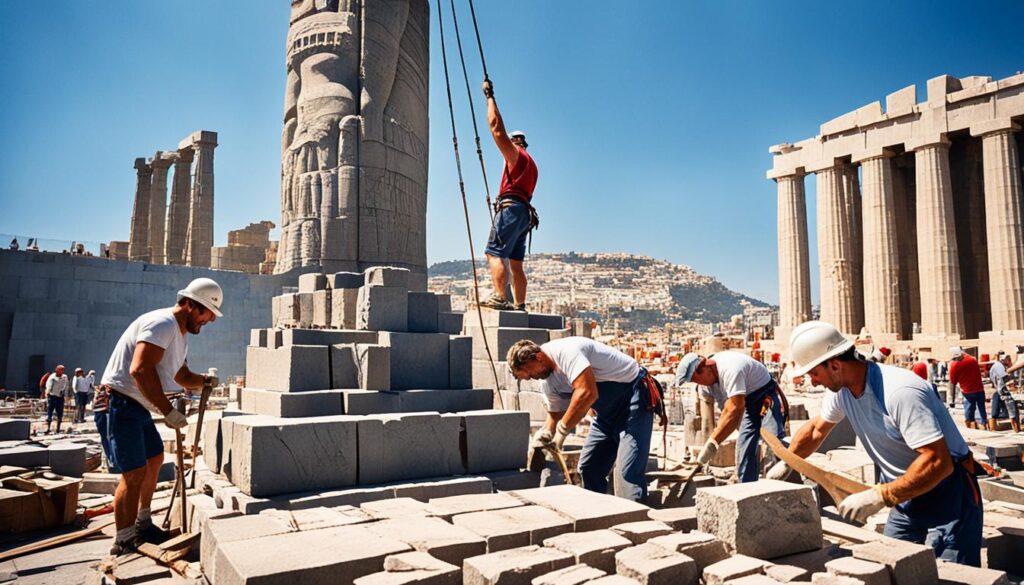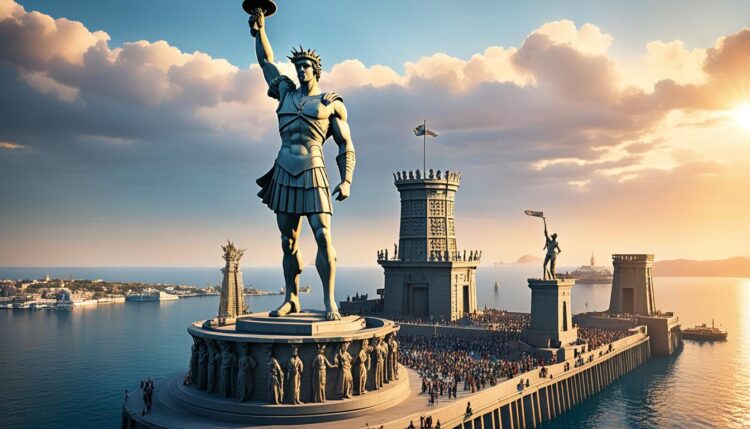What if the greatest marvel of antiquity wasn’t just a mythical story, but a true monument to innovation and human ingenuity? The Colossus of Rhodes, an awe-inspiring statue of the Greek sun god Helios, was not only one of the most towering wonders of the ancient world but also a symbol of triumph and freedom for Rhodes city.
Constructed by Chares of Lindos in 280 BC to celebrate the victory over Demetrius I of Macedon, this magnificent statue stood at an imposing height of 33 meters (108 feet), paralleling the modern Statue of Liberty in scale. Although the Colossus ruled the harbor for only 54 years before collapsing due to an earthquake in 226 BC, its legacy persisted for centuries, cementing its place in history as a beacon of ancient innovation.
The Historical Context of Ancient Rhodes
Throughout the Hellenistic period, Rhodes emerged as a crucial player in the Mediterranean due to its strategic position and formidable maritime capabilities.
Geopolitical Importance
Rhodes was strategically located, providing a pivotal advantage in controlling sea routes and trade. This island’s alliance with Ptolemy I of Egypt significantly bolstered its geopolitical clout, forming a united front against powerful adversaries like Antigonus I Monophthalmus. Rhodes’ strategic position enabled it to influence regional politics and maintain autonomy from larger Hellenistic kingdoms.
Cultural Significance
In addition to its geopolitical prominence, Rhodes was a beacon of cultural achievements. The island was renowned for its harbors, which played a critical role in curbing piracy and ensuring safe maritime travel. The Rhodians were not only admired for their naval prowess but also for their dedication to arts, philosophy, and statecraft during the Hellenistic period. Their cultural achievements were further cemented through monumental projects, such as the construction of the Colossus, symbolizing their victory and independence.
The Siege of Rhodes: A Turning Point
In the face of a formidable assault by Demetrius I, the island of Rhodes exhibited extraordinary resilience. The Siege of Rhodes became a critical juncture in its storied history, showcasing ancient military strategies that would forever mark their legacy.
Conflict with Demetrius I
The conflict with Demetrius I was intense and grueling, as his forces sought to overpower the island. Defense against Demetrius I was orchestrated with meticulous planning and deployed with remarkable effectiveness. Despite facing a powerful adversary, the Rhodians’ strategic prowess and steadfast determination held the upper hand, leading to a surprising withdrawal by Demetrius’ army.
Aftermath and Celebration
Following the retreat, the Rhodians demonstrated prudent judgment by selling the abandoned siege equipment. This successful Defense against Demetrius I led to a period of victory commemorations, as the islanders resolved to celebrate their triumph. They allocated the proceeds towards the construction of the Colossus, a testimony to their resilience. The grand celebration and the creation of the Colossus marked the beginning of an illustrious chapter in Rhodes’ history, ensuring their victory commemorations were remembered for generations.
Planning the Colossus
The creation of the Colossus was an extraordinary feat that started with meticulous planning. This awe-inspiring work combined colossal engineering with artistic mastery, reflecting the rich cultural legacy of Ancient Greece.
Chares of Lindos: The Mastermind
Chares of Lindos, a distinguished sculptor, was the brilliant mind behind the Colossus. Known for his exceptional skill, Chares had previously worked on an enormous statue of Zeus, earning a reputation for his artistic mastery. He was deeply involved in every aspect of the planning and execution of the Colossus, ensuring that it embodied the highest standards of artistic and engineering excellence.
Design and Symbolism
The design of the Colossus was a tribute to the sun god Helios, with its representation symbolizing the power and independence of Rhodes. Using traditional Greek methodology, the project faced formidable engineering challenges to achieve its grand scale. The intricate details and scale of the statue showcased the Rhodians’ commitment to both artistic mastery and colossal engineering, making it a marvel of the ancient world.
| Aspect | Details |
|---|---|
| Mastermind | Chares of Lindos |
| Symbolism | Helios representation |
| Engineering | Colossal Engineering |
| Artistic Elements | Artistic Mastery |
Construction of an Ancient Marvel
The construction of the Colossus of Rhodes stands as a testament to the ingenuity and resourcefulness of ancient builders. Employing ancient construction techniques, the project utilized iron tie bars and brass plates to form the towering statue’s framework. Massive stone blocks served as foundational supports, combining strength with stability.
A particularly noteworthy aspect of the Colossus’ construction was the innovative use of local resources. The interior comprised ascending stone fills, while the evolving bronze skin was crafted principally from repurposed weaponry left over from Demetrius I’s siege. This practice not only highlighted their innovative building methods but also demonstrated a remarkable level of resourcefulness.

The role of bronze casting was pivotal in rendering the Colossus its majestic appearance. Expert artisans meticulously melted bronze to create the exterior plates that adorned the statue, giving it a formidable and awe-inspiring presence. These ancient construction methods revealed an advanced understanding of materials and processes far ahead of their time.
| Technique | Material | Purpose |
|---|---|---|
| Iron Tie Bars | Iron | Structural Integrity |
| Brass Plates | Brass | Exterior Shielding |
| Stone Blocks | Stone | Foundation Support |
| Bronze Casting | Bronze | Surface Appearance |
The Colossus of Rhodes
The Colossus of Rhodes remains an enduring symbol of the ingenuity and artistic achievements of ancient Greece. This section delves into the dimensions and materials that contributed to its monumental scale and unparalleled artistic feat.
Dimensions and Scale
Standing at an awe-inspiring height of 33 meters, the Colossus commanded the attention of all who visited the harbor of Rhodes. Resting on a pedestal measuring 18 meters in diameter, its monumental scale was not merely a technical accomplishment but also a statement of the city’s prosperity and resilience. This grandiose structure was one of the tallest statues of its time, symbolizing the zenith of Hellenistic artistry and engineering.
Materials Used
The creation of the Colossus employed sophisticated techniques and materials that underscored its dual layer of technical and artistic prowess. The statue utilized an iron framework, a testament to the advanced metallurgical skills of the period. Each bronze plate used in its construction highlighted the exceptional craftsmanship in bronze artistry, making it a true artistic feat of ancient Greece. These materials were meticulously selected and assembled to ensure both the statue’s stability and its striking visual impact.
| Aspect | Description |
|---|---|
| Height | 33 meters |
| Pedestal Diameter | 18 meters |
| Main Structure | Iron Framework |
| Outer Layer | Bronze Plates |
The Statue’s Architectural Innovations
The Colossus of Rhodes stands as a testament to groundbreaking architecture and ancient innovations that dazzled the world. This engineering marvel demonstrated exceptional methodologies in bronze casting and structural advancements that have been influential throughout history.
One of the most impressive features was the tailored metal thickness that fortified the structure. This meticulous attention to detail ensured stability and endurance, making the statue a symbol of engineering prowess.
Greek architects and engineers behind the Colossus employed advanced techniques in construction that were visionary for their era. They utilized sophisticated scaffolding methods and subtle weight distribution strategies, making the statue an unparallelled structural advancement.
The integration of these ancient innovations highlights the remarkable skill level and creativity of Hellenistic engineers. Their choices in material and design not only brought the colossal figure to life but also set a benchmark in engineering marvels for future generations.
The Colossus’ Role in Maritime History
More than just an artistic masterpiece, the Colossus of Rhodes held significant roles in maritime history. As a prestigious symbol of prosperity and protector of the island, it encapsulated the maritime heritage of Rhodes. This impressive statue was much more than a testament to human innovation; it was a shining representation of the island’s hard-won freedom and dominance.
A Beacon of Freedom
The Colossus stood as a well-regarded beacon of freedom. Its imposing presence symbolized the victory of the Rhodians over the invading forces of Demetrius I. Towering above the harbor, it served not just as a monument but as a potent reminder of ancient Rhodes’ dominance and independence. This sense of liberty was crucial in maintaining the morale and unity of the Rhodes community.
Harbor Defense Mechanism
Apart from its role as a mental and cultural landmark, the Colossus also functioned as a vital harbor defense mechanism. Serving both as a deterrent and a protective guardian, it was indicative of the island’s strategic importance in the Aegean Sea. Its mere sight was enough to discourage potential invaders and solidify Rhodes’ position as a fortified and formidable maritime power in the ancient world.
| Feature | Symbolic Role | Defensive Role |
|---|---|---|
| Height | Represented the resilience and victory of Rhodes | Provided unparalleled visibility and watchfulness |
| Location | Placed at the harbor entrance to signify welcome and strength | Acted as a deterrent to potential naval threats |
| Symbol | Showcased maritime heritage and ancient dominance | Incited fear and respect from potential invaders |
The Great Earthquake of 226 BC
In 226 BC, a cataclysmic event struck the island of Rhodes, one that would irrevocably alter its landscape and history. This catastrophic natural disaster arrived in the form of a powerful earthquake, shaking the very foundations of the ancient city. The colossal statue of Helios, known as the Colossus of Rhodes, was not spared from this devastation. The enormous edifice, which stood as a symbol of Rhodian ingenuity and pride, was grievously damaged by the tremors, breaking at the knees and collapsing into a heap of spectacular ruins.
The momentous earthquake of 226 BC marked the end of an era for the people of Rhodes. The fall of the Colossus not only signified the loss of a marvel of the ancient world but also heralded significant changes in the city’s fortunes and spirit. As the dust settled and the extent of the destruction became apparent, the island’s inhabitants were faced with the daunting task of rebuilding their city and lives amidst the ruins. Despite the loss, this event etched itself into the annals of history as a poignant reminder of the island’s resilience and the transient nature of humankind’s greatest achievements.
The archaeological impact of the earthquake was profound. The colossal remnants of the statue became an enduring testament to the ingenuity of ancient engineers and artisans. For centuries, these ruins captivated the imaginations of historians, archaeologists, and tourists alike, serving as a powerful emblem of both human ambition and the unpredictable wrath of nature. Although the Colossus of Rhodes no longer stands tall, its legacy continues to echo through history, forever intertwined with the story of the Great Earthquake of 226 BC.













